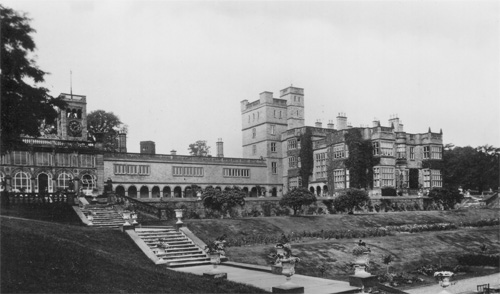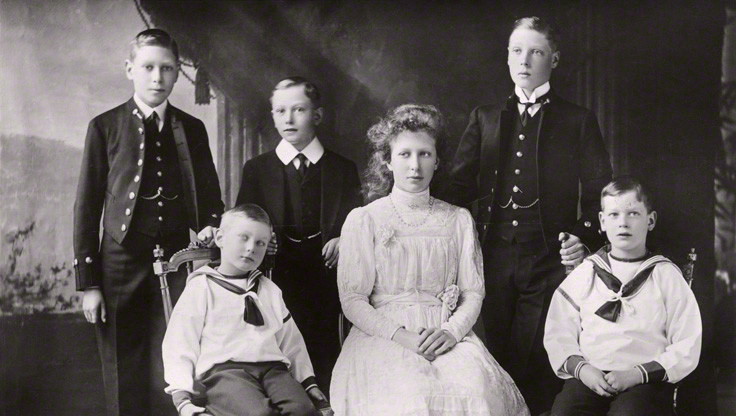|
Francis Wright (industrialist)
Francis Wright Justice of the Peace, JP Deputy Lieutenant, DL (21 December 1806 – 24 February 1873), was a British industrialist and philanthropist. Early life Wright was born on 21 December 1806, at Lenton Hall, Nottingham, the son of John Wright and Elizabeth Beresford. The Wrights were a landed family, supposedly of Genoa, Genoese origin, first settling in East Anglia and then in Nottinghamshire and, later, Derbyshire. Their line can be traced back to John Wright (alias Camplyon) of Stowupland, who lived in the sixteenth century. The name Camplyon is thought to have been anglicised from the Italian Camplioni. Wright's great-grandfather, Ichabod Wright (1700-1777) had set up Wright's bank, in Long Row, Nottingham, which in 1918 became part of Lloyds Bank, Lloyds bank. As the second son, Wright was set to spend life as a banker; however, on the premature death of his elder brother John in Italy in 1828, his father altered his will, making Francis his primary heir. Butte ... [...More Info...] [...Related Items...] OR: [Wikipedia] [Google] [Baidu] |
Osmaston, Derbyshire Dales
Osmaston is a small village and civil parish in the Derbyshire Dales in the county of Derbyshire in England. The population of the civil parish as taken at the 2011 Census was 140. Located two and a half miles south of Ashbourne, Derbyshire, Ashbourne, Osmaston is an archetypal English village with thatched cottages and a village pond. History The village is mentioned in the Domesday Book under the name Osmundestone; the parish was originally named Whitestone. The village church—St Martin's Church, Osmaston, St. Martin's—dates from 1606, although the present building was constructed in 1843. The building was previously a wickerwork construction. Points of interest The war memorial, by the road near the church, commemorates those lost in the First World War. The only pub in the village is the Shoulder of Mutton. There is also a village hall and a primary school. Osmaston Manor was designed by Henry Isaac Stevens for Francis Wright (industrialist), Francis Wright of the ... [...More Info...] [...Related Items...] OR: [Wikipedia] [Google] [Baidu] |
Henry Isaac Stevens
Henry Isaac Stevens FRIBA was an architect based in Derby. He was born in London, in 1806, and died in 1873. In the late 1850s he changed his name to Isaac Henry Stevens. Family His parents were Isaac Stevens and Elizabeth Young. He married Anne, the daughter of William Martin on 7 August 1832 in Repton, Derbyshire. They had four children. In the 1861, census he is listed as Isaac H Stevens living in Ashbourne Road, Mackworth, Derbyshire. In the 1871, census he is listed as living at 20 Peartree Road in Litchurch, Derby. Career He was articled to William Martin in Bretby, and was also a pupil of George Maddox. He started in independent practice in 1834 in Hartshorne, Derbyshire. He moved to Derby in the late 1830s or early 1840s and was based at 16 Full Street in Derby. By 1847 he was at 49 Friargate, Derby. In 1857 he is listed as living in Mackworth. He was awarded a Fellowship of the Royal Institute of British Architects on 21 January 1850. He entered into a partnership ... [...More Info...] [...Related Items...] OR: [Wikipedia] [Google] [Baidu] |
Church Mission Society
The Church Mission Society (CMS), formerly known as the Church Missionary Society, is a British mission society working with the Christians around the world. Founded in 1799, CMS has attracted over nine thousand men and women to serve as mission partners during its 200-year history. The society has also given its name "CMS" to a number of daughter organisations around the world, including Australia and New Zealand, which have now become independent. History Foundation The original proposal for the mission came from Charles Grant and George Uday of the East India Company and David Brown, of Calcutta, who sent a proposal in 1787 to William Wilberforce, then a young member of parliament, and Charles Simeon, a young clergyman at Cambridge University. The ''Society for Missions to Africa and the East'' (as the society was first called) was founded on 12 April 1799 at a meeting of the Eclectic Society, supported by members of the Clapham Sect, a group of activist Anglicans who met ... [...More Info...] [...Related Items...] OR: [Wikipedia] [Google] [Baidu] |
Earl Of Leven
Earl of Leven (pronounced "''Lee''-ven") is a title in the Peerage of Scotland. It was created in 1641 for Alexander Leslie. He was succeeded by his grandson Alexander, who was in turn followed by his daughters Margaret and Catherine (who are usually not included in the numbering of the Earls). Thereafter, there was a dispute relating to succession to the title between David Melville and John Leslie, 1st Duke of Rothes. However, in 1681, Melville's claim was admitted after the Duke of Rothes died. In 1707, Melville succeeded to the title Earl of Melville, and thereafter the earldoms have been united. The other titles held by the Earl are: Viscount of Kirkaldie (created 1690), Lord Melville of Monymaill (1616), Lord Balgonie (1641), Lord Raith, Monymaill and Balwearie (1690). All are in the Peerage of Scotland. The heir apparent to the Earldoms is styled Lord Balgonie. The family seat is Glenferness House, near Nairn, Highland. Earls of Leven (1641) *Alexander Leslie, 1st Earl o ... [...More Info...] [...Related Items...] OR: [Wikipedia] [Google] [Baidu] |
Hatchment Of Francis Wright
Hatchment may refer to: *Hatchment (heraldic achievement) In heraldry, an achievement, armorial achievement or heraldic achievement (historical: hatchment) is a full display or depiction of all the heraldic components to which the bearer of a coat of arms is entitled. An achievement comprises not only ..., a full display of all the heraldic components to which the bearer of a coat of arms is entitled * Funerary hatchment, a depiction within a black lozenge-shaped frame of a deceased's heraldic achievement {{Disambiguation ... [...More Info...] [...Related Items...] OR: [Wikipedia] [Google] [Baidu] |
Funerary Hatchment
A funerary hatchment is a depiction within a black lozenge-shaped frame, generally on a black (''sable'') background, of a deceased's heraldic achievement, that is to say the escutcheon showing the arms, together with the crest and supporters of his family or person. Regimental Colours and other military or naval emblems are sometimes placed behind the arms of military or naval officers. Such funerary hatchments, generally therefore restricted in use to members of the nobility or armigerous gentry, used to be hung on the wall of a deceased person's house, and were later transferred to the parish church, often within the family chapel therein which appertained to the manor house, the family occupying which, generally being lord of the manor, generally held the advowson of the church. In Germany, the approximate equivalent is a ''Totenschild'', literally "shield of the dead". Etymology The ancient term used in place of "achievement" was "hatchment", being a corruption (through ... [...More Info...] [...Related Items...] OR: [Wikipedia] [Google] [Baidu] |
Rugby School
Rugby School is a public school (English independent boarding school for pupils aged 13–18) in Rugby, Warwickshire, England. Founded in 1567 as a free grammar school for local boys, it is one of the oldest independent schools in Britain. Up to 1667, the school remained in comparative obscurity. Its re-establishment by Thomas Arnold during his time as Headmaster, from 1828 to 1841, was seen as the forerunner of the Victorian public school. It was one of nine prestigious schools investigated by the Clarendon Commission of 1864 and later regulated as one of the seven schools included in the Public Schools Act 1868. The school's alumni – or "Old Rugbeians" – include a UK prime minister, several bishops, prominent poets, scientists, writers and soldiers. Rugby School is the birthplace of rugby football. [...More Info...] [...Related Items...] OR: [Wikipedia] [Google] [Baidu] |
Prince Henry, Duke Of Gloucester
Prince Henry, Duke of Gloucester, (Henry William Frederick Albert; 31 March 1900 – 10 June 1974) was the third son and fourth child of King George V and Queen Mary. He served as Governor-General of Australia from 1945 to 1947, the only member of the British royal family to hold the post. Henry was the first son of a British monarch to be educated at school, where he excelled at sports, and went on to attend Eton College, after which he was commissioned in the 10th Royal Hussars, a regiment he hoped to command. However, his military career was frequently interrupted by royal duties, and he was nicknamed "the unknown soldier". While big-game shooting in Kenya, he met the future pilot Beryl Markham, with whom he became romantically involved. The court put pressure on him to end the relationship, but he had to pay regular hush-money to avert a public scandal. In 1935, also under parental pressure, he married Lady Alice Montagu Douglas Scott, with whom he had two sons, Princes ... [...More Info...] [...Related Items...] OR: [Wikipedia] [Google] [Baidu] |
Francis, Duke Of Teck
, house = Teck , father = Duke Alexander of Württemberg , mother = Countess Claudine Rhédey von Kis-Rhéde , birth_name = Count Francis von Hohenstein , birth_date = , birth_place = Esseg, Slavonia, Austrian Empire(modern-day Osijek, Croatia) , death_date = , death_place = White Lodge, Richmond Park, Surrey, England , burial_date = 27 January 1900 , burial_place = St George's Chapel, Windsor Castle Francis, Duke of Teck, (Francis Paul Charles Louis Alexander; 28 August 1837 – 21 January 1900) known as Count Francis von Hohenstein until 1863, was an Austrian-born nobleman who married into the British royal family. His wife, Princess Mary Adelaide of Cambridge, was a first cousin of Queen Victoria. He was the father of Queen Mary, the consort of King George V. Francis held the Austrian title of Count of Hohenstein (''Graf von Hohenstein''), and the German titles of Prince (''Fürst'') and later Duke of Teck (''Herzog von Teck''), ... [...More Info...] [...Related Items...] OR: [Wikipedia] [Google] [Baidu] |
Okeover Hall
Okeover Hall is a privately owned Grade II* listed country house in Okeover, Staffordshire, England. It is the family seat of the Okeover family, who have been in residence since the reign of William Rufus. The house lies close to the border between Staffordshire and Derbyshire, which lies on the far side of the small River Dove. The Hall is not open to the public. The house and manor church (14th century, restored by Sir George Gilbert Scott) were pillaged by the Jacobite forces as they marched south to Swarkstone Bridge in 1745. In 1745–47, Leak Okeover had the old hall enlarged to Palladian designs by a London carpenter and joiner, Joseph Sanderson, a cousin of John Sanderson, the architect. The house is a testament to the high level of education and competence that might be elicited from a well-trained Georgian craftsman. The Georgian east wing is the oldest part of the house dating from 1745 to 1746. A north wing was demolished in the early 19th century. The south and we ... [...More Info...] [...Related Items...] OR: [Wikipedia] [Google] [Baidu] |




